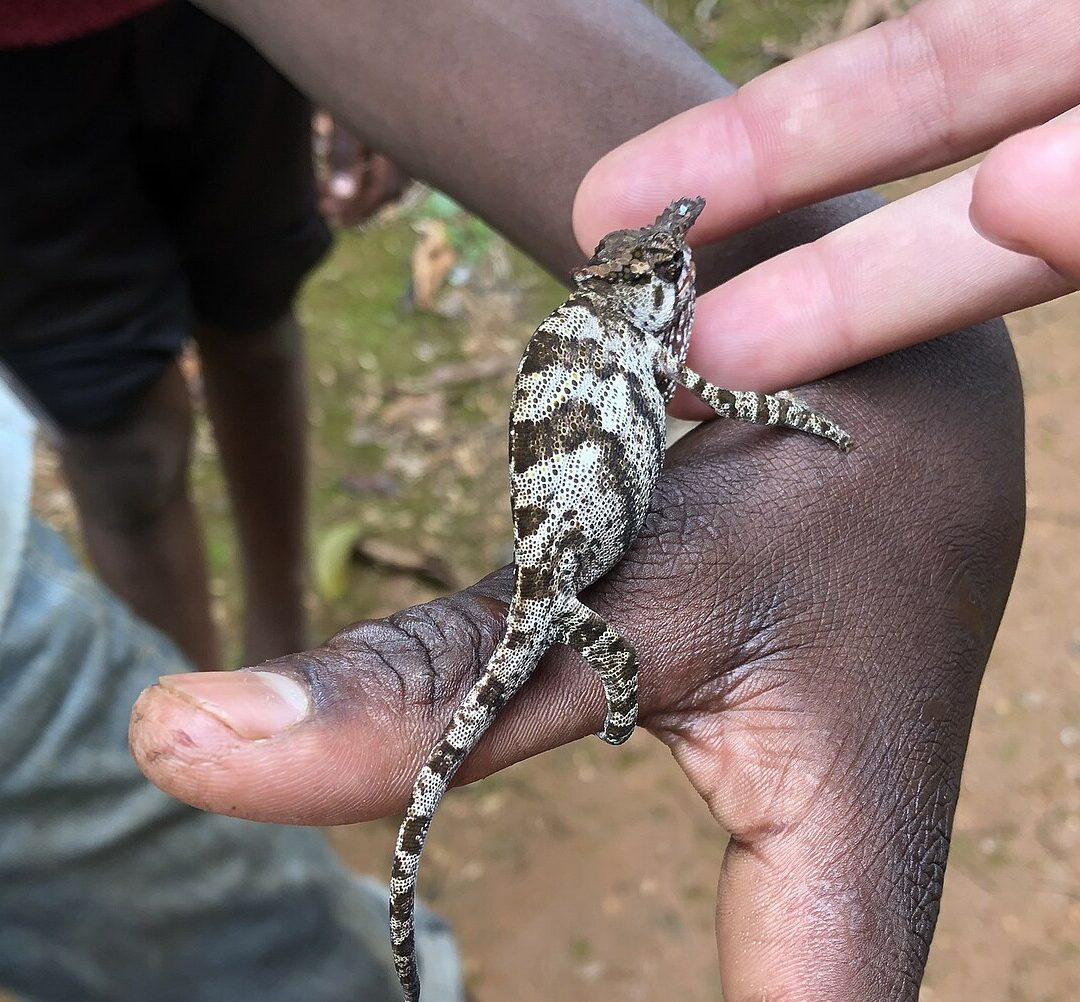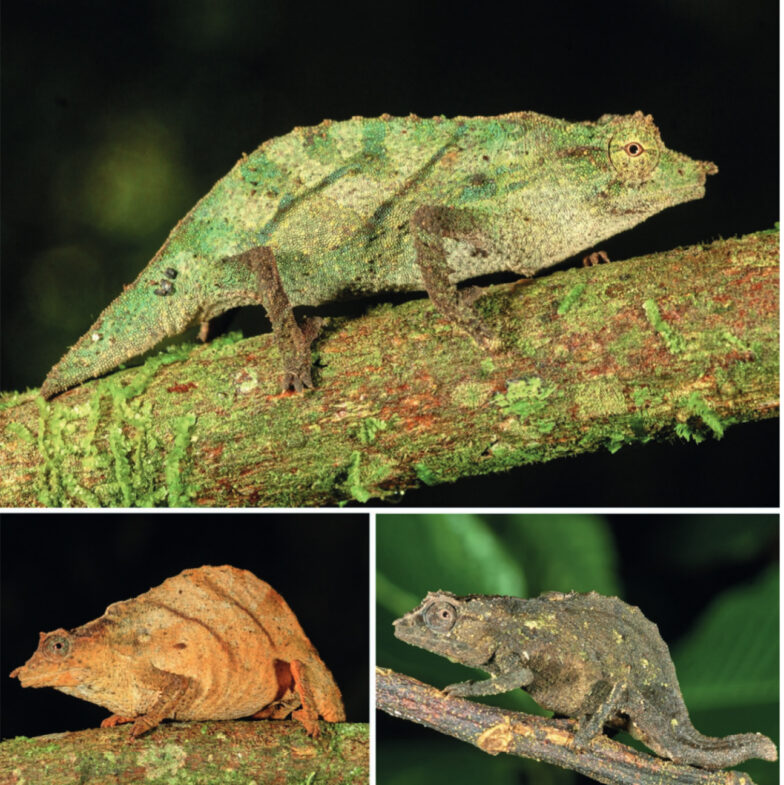In the last 15 years, the number of known Rhampholeon species has doubled – not least because some species complexes “hid” numerous undescribed species. Scientists from Great Britain, Tanzania, and South Africa have now shed light on exactly such a case: the Rhampholeon uluguruensis/moyeri complex. The pygmy chameleons from this complex inhabit different habitats in the Eastern Arc Mountains, a 600 km long mountain range stretching from Kenya to Tanzania. The most striking feature of the genus Rhampholeon so far is that the described species differ only slightly in appearance, but occur in narrowly defined habitats that are usually completely isolated from each other. The authors studied pygmy chameleons from seven different locations in Tanzania. In the process, they were able to identify six new Rhampholeon species by means of genetic studies.
Rhampholeon colemani was named after the conservationist Carter Coleman. The species occurs in the Kitolomero Valley at about 1200 m a.s.l.. The valley is located in the Uzungwa Scarp Nature Reserve in the Udzungwa Mountains in the middle of Tanzania, about 350 km south-east of the capital Dodoma. What is special about this distribution area is that the already-known Rhampholeon moyeri also occurs in this reserve. It is still unclear whether the two species possibly live at different altitudes. Rhampholeon colemani grows up to 44 mm (TL) and is thus the second smallest of the Rhampholeon species described so far. The hemipenes of the males of these species could be described in detail. A characteristic feature of Rhampholeon colemani is the rostral appendage, which is at an angle of up to 59° to the snout or points slightly downwards. In all other terrestrial chameleons of the genus, the angle is much smaller, so the rostral appendage is rather straightforward.
Rhampholeon sabini was named in honour of Andy Sabin for his financial support and worldwide commitment to conservation. The species lives in Tanzania in the sub-montane rainforest of two neighbouring reserves, which are located in the north-east of the country about 250 km from the coastal city of Dar es Salaam. One of the habitats is the Nguu North Forest Reserve, the other the Kilindi Forest Reserve, both at an altitude of just over 1200 m above sea level. Rhampholeon sabini grows up to 54 mm, with the relative size of the head and tail appearing larger in relation to the rest of the body than in the other species.
Rhampholeon rubeho occurs on the mountains of the same name, the Rubeho Mountains, at about 1870 m a.s.l., located about 150 km east of the capital Dodoma. The rainforest inhabited by this species is mainly in the Mafwomero Forest Reserve. Rhampholeon rubeho grows up to 63 mm long. In addition, scientists currently count a population of earth chameleons in the Ilole Forest Reserve 50 km away, on the southern foothills of the Rubeho Mountains, as belonging to this species. However, this population has not yet been genetically studied.
Rhampholeon nicolai was named after the late Nicola Colangelo, a Tanzanian entrepreneur who promoted species conservation and sustainable resource use. Rhampholeon nicolai grows up to 60 mm long, and similar to R. sabini, the relative size of the head and tail in relation to the rest of the body appears larger than in the other species. Rhampholeon nicolai lives in the Ukaguru Mountains, just north of the Rubeho Mountains. It has been recorded in the three contiguous protected areas of Mamiwa Kisara North Forest Reserve, Mamiwa Kisara South Forest Reserve and the Ikwamba Forest Reserve at 1970 m altitude. A population of ground chameleons in nearby Mikuvi Forest is initially counted as part of the species, but its exact status has yet to be investigated.
Rhampholeon waynelotteri was given its name in honour of the murdered South African conservation activist Wayne Lotter, who was particularly active in the fight against elephant poaching. This pgymy chameleon grows up to 55 m tall. It inhabits Mount Kanga, about 120 km from the Indian Ocean coast. Mount Kanga is part of the Nguru Mountains, although the mountain is separated from the main massif by an 8 km wide lowland corridor and a river. Rhampholeon waynelotteri is described from the Kanga Forest Reserve at about 1280 m as well as de Mkingu Nature Reserve. In the latter, it occurs together with Rhampholeon acuminatus, from which it can be easily distinguished by its differently shaped rostral appendage and small appendages above the eyes. A pygmy chameleon population on Mount Nguru was initially attributed to Rhampholeon waynelotteri, but further research is pending.
Rhampholeon princeeai was named after the American artist and YouTuber Prince Ea. Rhampholeon princeeai lives at altitudes of 1870 m in the Mkingu Nature Reserve on the Nguru Mountains. Rhampholeon waynelotteri and Rhampholeon acuminatus also occur there. The species grows up to 46 mm long and has a special feature: the rostral appendage has a triangular shape when viewed from above. In addition, the species has a small depression in the inguinal region, which the other species studied so far do not have.
The already known species Rhampholeon uluguruensis was found exclusively in the Uluguru Nature Reserve and the Mkungwe Forest Reserve. Rhampholeon moyeri is found only in the Uzungwa Scarp Nature Reserve in the Udzungwa Mountains. Rhampholeon beraduccii is restricted to the Sali Forest Reserve in the Mahenge Mountains and Rhampholeon acuminatus, as anticipated, lives exclusively in the Mingu Nature Reserve in the Nguru Mountains.
Cryptic diversity in pygmy chameleons (Chamaeleonidae: Rhampholeon) of the Eastern Arc Mountains of Tanzania, with description of six new species
Michelle Menegon, John V. Lyakurwa, Simon P. Loader, Krystal A. Tolley
Acta Herpetologica 17 (2): 85-113, 2022
DOI: 10.36253/a_h-12978
Photo: Rhampholeon rubeho, from the above-mentioned publication







